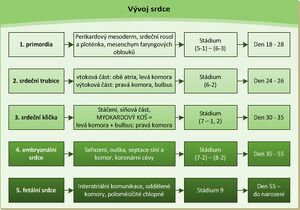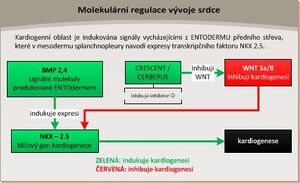Development of the heart
Establishment of cardiogenic fields[edit | edit source]
The vascular system begins to develop in the middle of 3. week of embryonic development, when the nutrition of the embryo can no longer be ensured only by diffusion. The cardiogenic field is a region of the embryo formed by a horseshoe-shaped tube lined with endothelium and surrounded by myoblasts. Cardiogenic cells are found in the epiblast' lateral to the primitive streak. From there they migrate through the primitive streak in a certain craniocaudal order. The cells for the formation of the left ventricle travel first.
In the late presomitic period of development, the entoderm pharyngu, deposited beneath these cells, induces their differentiation into cardiac myoblasts.
The ``pericardial cavity later separates from the ``intraembryonic cavity around the cardiogenic field. Additional hemangiogenic cells outside the cardiogenic area form bilaterally along the midline germinal target. Paired longitudinal vessels - DORSAL AORTS will arise from these cells.
Origin and position of heart tube[edit | edit source]
The central part of the cardiogenic region is initially located in front of the oropharyngeal membrane and the neural plate. However, the central nervous system grows rapidly cranially so that it extends over the central cardiogenic region and the future pericardial cavity, as a result of this growth the oropharyngeal membrane is pulled forward, while the heart and pericardial cavity descend first into the neck and then into the thoracic region. As a result of the bending of the embryo in the transverse plane, the caudal regions of the paired heart bases merge, at the same time the apical part of the horseshoe region expands, thus creating the future outflow compartment of the heart and ventricle. The heart thus gradually becomes a continuous tube, consisting of an inner endothelial and an outer myocardial layers. At its caudal end it receives venous tributaries and at its cranial end it begins to pump blood through the 1st aortic arch into the dorsal aorta.
During development, the heart tube increasingly arches into the pericardial cavity', but initially it is attached to the dorsal side of the pericardial cavity by a flap of mesoderm tissue - the dorsal mesocardium' (note. ventral mesocardium not formed). Subsequently, the dorsal mesocardium disappears and thus the sinus transversus pericardii is formed, which connects the two sides of the pericardial cavity.
The heart is now suspended in the pericardial cavity by the vessels at its cranial and caudal ends. During development, the myocardium ``thickens and produces ``cardiac jelly (a thick layer of intercellular material that separates the myocardium from the endocardium and has a high content of ``hyaluronic acid) . At the same time, the mesothelial cells form a proepicardial organ located on the surface of the septum transversum near the sinus venosus, the migration of its cells along the surface of the heart forms the majority of the epicardium, the remaining part of the epicardium arises from the 'mesothelial cells in the region of the outflow part of the heart. In this way, 3 layers of the heart tube are gradually formed:
- endocardium - forms the endothelial lining of the heart;
- myocardium - forms the muscle of the heart walls;
- epicardium (visceral sheet of the pericardium) - covers the surface of the heart tube and then differentiates from it the coronary vessels.
Formation of a heart loop[edit | edit source]
The heart tube continues to elongate and the 23rd day of development begins to bend:
- Cranial part of the tube bends: ventrally + caudally + to the right.
- Caudal part of the (atrial) tube bends: dorsally + cranially + to the left.
The process is completed 28. day.
The following bulges appear during development:
- Atrial compartment - originally a paired structure - forms a common atrium and is taken into the pericardial cavity. The atrioventricular junction remains narrow and forms the canalis atrioventricularis, connecting the primitive atrium and ventricle.
- Bulbus cordis - the right ventricle (its trabecular part) arises from the third closest to the chamber, the outlet parts of both chambers arise from the central part of the bulb (conus arteriosus). The aorta and truncus pulmonalis are formed from the "truncus arteriosus" part.
Molecular regulation of heart development[edit | edit source]
The signaling molecules are BMP2' and BMP4 produced by the endoderm and also the mesoderm ' lateral plates. Furthermore, it is necessary to block the activity of the proteins WNT 3a and WNT 8, which are released from the neural tube, as these proteins are inhibitors of cardiogenesis.
The signaling molecules "crescent" and "cerberus" produced in the entoderm adjacent directly to the cardiogenic mesoderm in the anterior half of the embryo are used as ""inhibitors of WNT proteins". The combination of BMP activation and WNT inhibition by crescent and cerberus factors induces the expression of NKX2.5, a key gene of cardiogenesis.
Links[edit | edit source]
Related Articles[edit | edit source]
- Embryonic heart septation
- Development of arteries
- Stages of Embryo and Fetus Development
- Third week of embryo development
- Embryonic heart septation
References[edit | edit source]
- SADLER, Thomas, W. Langman's Medical Embryology. 1. Czech edition. Grada, 2011. 414 pp. ISBN 978-80-247-2640-3.
- MOORE, Keith L – PERSAUD, T. V. N. The Birth of Man. 1. edition. ISV, 2002. 564 pp. ISBN 80-85866-94-3.



